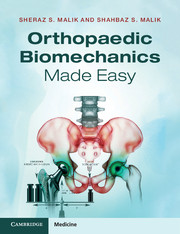Book contents
- Frontmatter
- Dedication
- Contents
- Contributors
- Epigraph
- Preface
- Acknowledgements
- Part I Orthopaedic biomaterials and their properties
- Part II Engineering theory applied to orthopaedics
- Part III Clinical biomechanics
- 6 Biomechanics of the hip and total hip replacement
- 7 Biomechanics of the knee and total knee replacement
- 8 Biomechanics of the shoulder
- 9 Biomechanics of the elbow
- 10 Biomechanics of the spine
- 11 Biomechanics of the ankle and foot
- 12 Biomechanics of fracture fixation
- 13 Trauma meeting: case-based discussions
- Index
7 - Biomechanics of the knee and total knee replacement
from Part III - Clinical biomechanics
Published online by Cambridge University Press: 05 June 2015
- Frontmatter
- Dedication
- Contents
- Contributors
- Epigraph
- Preface
- Acknowledgements
- Part I Orthopaedic biomaterials and their properties
- Part II Engineering theory applied to orthopaedics
- Part III Clinical biomechanics
- 6 Biomechanics of the hip and total hip replacement
- 7 Biomechanics of the knee and total knee replacement
- 8 Biomechanics of the shoulder
- 9 Biomechanics of the elbow
- 10 Biomechanics of the spine
- 11 Biomechanics of the ankle and foot
- 12 Biomechanics of fracture fixation
- 13 Trauma meeting: case-based discussions
- Index
Summary
Knee: functional anatomy I
The knee is the largest and most complex joint in the body. It is an articulation among the distal femur, proximal tibia and patella, surrounded by a soft tissue envelope of capsule, ligaments, tendons and muscles. The specific anatomical features and interactions of these structures determine the stability and movements of the knee joint.
Tibiofemoral joint
The medial tibial plateau is larger than the lateral tibial plateau. It also has a concave depression whereas the lateral tibial plateau has a convex surface. Both plateaux have a posterior tilt of about 7°, but the joint surface tilt is minimised to 3° by the menisci. The plateaux also have a 3° varus tilt, i.e. the joint surface is slopped medially.
On the femoral side, the medial condyle is larger, more curved and extends more distally than the lateral condyle.
This asymmetry between the medial and lateral compartments of the knee determines the relative mobility of each compartment. The concave medial tibial plateau offers more constraint and the convex lateral tibial plateau offers less constraint to the movements of their respective femoral condyles. The posterior and varus tilts of the tibial plateaux have implication for the alignment of bone cuts for total knee replacement.
- Type
- Chapter
- Information
- Orthopaedic Biomechanics Made Easy , pp. 112 - 125Publisher: Cambridge University PressPrint publication year: 2015



